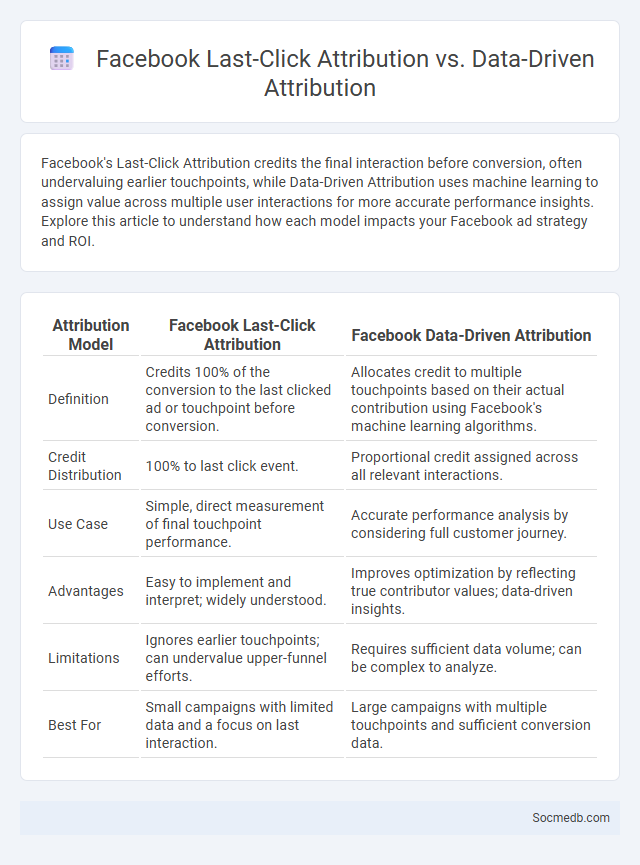
Photo illustration: Facebook Last-Click Attribution vs Data-Driven Attribution
Facebook's Last-Click Attribution credits the final interaction before conversion, often undervaluing earlier touchpoints, while Data-Driven Attribution uses machine learning to assign value across multiple user interactions for more accurate performance insights. Explore this article to understand how each model impacts your Facebook ad strategy and ROI.
Table of Comparison
| Attribution Model | Facebook Last-Click Attribution | Facebook Data-Driven Attribution |
|---|---|---|
| Definition | Credits 100% of the conversion to the last clicked ad or touchpoint before conversion. | Allocates credit to multiple touchpoints based on their actual contribution using Facebook's machine learning algorithms. |
| Credit Distribution | 100% to last click event. | Proportional credit assigned across all relevant interactions. |
| Use Case | Simple, direct measurement of final touchpoint performance. | Accurate performance analysis by considering full customer journey. |
| Advantages | Easy to implement and interpret; widely understood. | Improves optimization by reflecting true contributor values; data-driven insights. |
| Limitations | Ignores earlier touchpoints; can undervalue upper-funnel efforts. | Requires sufficient data volume; can be complex to analyze. |
| Best For | Small campaigns with limited data and a focus on last interaction. | Large campaigns with multiple touchpoints and sufficient conversion data. |
Understanding Attribution Models in Facebook Advertising
Understanding attribution models in Facebook advertising helps you accurately measure the impact of your campaigns by assigning credit to different touchpoints in the customer journey. Facebook offers models like last click, linear, and time decay, each providing unique insights into how users interact with your ads before converting. Choosing the right attribution model optimizes your ad spend, improves targeting strategies, and enhances overall ROI by aligning with your specific business goals and customer behavior.
What is Last-Click Attribution?
Last-Click Attribution is a model used in social media marketing to assign 100% of the conversion credit to the final interaction or click before a user completes a desired action, such as a purchase or sign-up. This approach helps you understand which specific social media ad, post, or campaign directly influenced the user's decision to convert. By focusing on the last touchpoint, marketers can optimize budgets and strategies based on the most impactful user engagements.
Exploring Data-Driven Attribution
Data-driven attribution uses machine learning to analyze customer journeys and assign credit to each marketing touchpoint based on its actual impact on conversions. Social media platforms provide rich behavioral data that enables deeper insights into user interactions, optimizing ad spend across channels. Leveraging these data-driven insights helps marketers refine strategies, enhance campaign performance, and accurately measure return on investment in social media advertising.
Defining Conversions in Facebook Ads
Defining conversions in Facebook Ads involves specifying the key actions you want users to take, such as purchases, sign-ups, or app installs, which directly influence your campaign's success. By setting clear conversion events within Facebook Pixel or Conversions API, you enable precise tracking and optimization tailored to Your business goals. Understanding and selecting relevant conversion metrics enhances ad performance and maximizes return on ad spend.
How Last-Click Attribution Impacts Campaign Performance
Last-click attribution assigns full credit for a conversion to the final interaction before the sale, which may undervalue earlier touchpoints in your social media campaign. This model can skew performance data, leading to misallocation of budget toward channels or posts closer to conversion moments. Understanding this impact helps you optimize your strategy by incorporating multi-touch attribution models that better reflect the entire customer journey.
Advantages of Data-Driven Attribution for Marketers
Data-driven attribution enables marketers to precisely analyze the impact of each customer touchpoint, maximizing campaign ROI through accurate performance insights. Leveraging machine learning, this method allocates credit based on actual consumer behavior, helping you optimize budget allocation and improve targeting strategies. Enhanced data accuracy from platforms like Google Analytics empowers marketers to make informed decisions, driving higher conversion rates and better audience engagement.
Comparing Last-Click vs Data-Driven Attribution Models
Last-click attribution gives full credit to the final interaction before a conversion, often overlooking the impact of earlier touchpoints across social media channels. Data-driven attribution uses machine learning to analyze the entire customer journey, assigning proportional value to each interaction based on its influence on your conversion. This model improves your understanding of how different social media campaigns contribute to sales, allowing better budget allocation and strategy optimization.
Attribution Influence on Conversion Optimization
Attribution influence plays a critical role in conversion optimization by accurately identifying which social media channels effectively drive customer actions and sales. By leveraging multi-touch attribution models, marketers can assess the impact of each social media touchpoint along the buyer's journey, enabling better budget allocation and campaign adjustments. Utilizing data from platforms like Facebook Insights and Google Analytics enhances decision-making, ultimately increasing return on ad spend (ROAS) and conversion rates.
Best Practices for Selecting an Attribution Model
Choosing the right social media attribution model requires analyzing how each platform contributes to your customer's journey, ensuring accurate measurement of engagement and conversions. Focus on models like multi-touch attribution to capture the impact of various interactions across channels, which helps optimize your ad spend and content strategy. Understanding these best practices empowers you to allocate resources effectively and enhance your overall social media marketing performance.
Measuring ROI: Attribution Models and Facebook Ad Success
Measuring ROI on social media campaigns involves using attribution models such as last-click, first-click, and multi-touch to accurately assign value to Facebook ad interactions. Facebook's Ads Manager provides detailed metrics like conversion tracking, cost per acquisition (CPA), and return on ad spend (ROAS), enabling marketers to optimize budget allocation. Employing data-driven attribution enhances campaign effectiveness by identifying high-performing touchpoints within the user journey.
 socmedb.com
socmedb.com